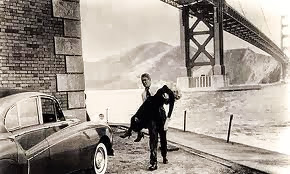Based on the novel by Vera Caspary and adapted by various scribes, Laura started modestly as mystery yarn released in 1944 and has grown in stature as a haunting, film noir classic. It was begun by veteran director Rouben Mamoulian (Dr. Jekyll and Mr. Hyde) with a young producer, Otto Preminger. Due to creative differences, Mamoulian was replaced by 20th Century Fox boss Darryl F. Zanuck, and Preminger took over directorial reins and made significant changes in casting and story.
The horrific murder of Laura Hunt
(Gene Tierney) triggers an investigation headed by cynical detective Mark McPherson
(Dana Andrews). Among a rogues gallery
of suspects is Waldo Lydecker (Clifton Webb, priceless in a star making turn),
an acerbic, caustic writer, Shelby Carpenter (Vincent Price), a charming playboy,
and Ann Treadwell (Judith Anderson), a socialite. Told in a series of flashbacks, Laura ascends
the world of advertising and garners the admiration and desires among the men
in her life. McPherson becomes intrigued
and fascinated by her even in death. As
he searches for more clues in her apartment, he finds himself strangely drawn
to her lifelike portrait until one fateful night when his world changes
forever.
What a marvelous cast. While it lacked a bonafide superstar, the
film more than compensated with a roster of wonderful character actors and
supporting players at their best. First
and foremost, the priceless Webb was already 53 years old with this breakout
role and earned an Oscar nomination. He
subsequently had a distinguished career playing eccentric, loveable leads in
such films as Cheaper by the Dozen
(which was remade starring Steve Martin), Sitting
Pretty (the original Mr. Belvedere
before a TV version), and a very credible version of Titanic. Gene Tierney was a stunningly beautiful actress who would
grace memorable films as in her Oscar nominated role in Leave Her to Heaven and the classic, The Ghost and Mrs. Muir.
Dana Andrews starred in many films over a couple decades including The Best Years of Our Lives and The Crowded Sky (a direct inspiration
for the parody Airplane.). You see
Vincent Price in a strong role before he made his mark as the king of horror
films (House of Wax, Pit and Pendulum). Judith Anderson was versatile among theater,
film, and television in a career spanning a majority of the twentieth century
ranging from Alfred Hitchcock’s Rebecca to
Star Trek III: The Search for Spock
as a Vulcan!
What seals Laura’s reputation forever is the romantic pull of not just a
gorgeous femme fatale (Tierney), but a dead one at that! The story captivates
your attention with its romantic longing and seedy mystery interspersed with humorous
moments and unique twists. It’s also filled with sharp dialogue particularly
the crackling lines spouted by Webb and ends with what must be one of the most
famous last lines in movie history. The
film’s point of view employs the occasional use of voiceover, and one could
imagine director Martin Scorsese being inspired by that device to use in some
of his films (Good Fellas, The Wolf of Wall Street).
Technical achievements excelled
for what was essentially a B-movie.
Joseph LaShelle won a much deserved Oscar for his imaginative, black and
white cinematography which displayed camera movement seldom seen up to that
point (even though earlier German cinema had already pioneered the language of film
noir). The film deserves to be seen in a
movie theater setting. I was fortunate
to watch this projected on a screen, uncut; it makes a huge difference.
What has significantly contributed
to the legend of this film is its memorable theme music by composer David
Raksin. What other title from film
noir’s heyday boasts such a romantic score?
(I don’t count Chinatown or Body Heat which were post-period
homages.)
Although Preminger would
subsequently have his moments in the sun with films that notoriously courted controversy
(Anatomy of a Murder, The Man With the
Golden Arm), none of the other principals behind or in front of the camera
would ever surpass their success with Laura. Movie watchers may recognize distinct
parallels in plot to a 1981 Burt Reynolds action film, Sharky’s Machine.
The fact that Laura plays so well in the modern era is
a testament to its unique storyline, great characterizations, and a confluence
of technical acumen. The film had a
total of five Oscar nominations including one for Preminger. In 1999, it was added to the National Film
Registry at the Library of Congress. A
supreme example of the old studio system at its finest and a highlight of
American film noir, Laura is one of
the best films from Hollywood’s golden age.
Love that painting!
**** of ****stars


